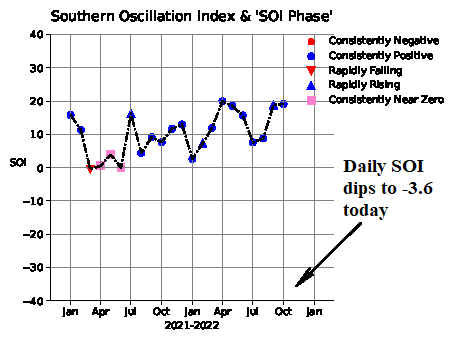Extreme Rain Risk in Australia Fading; Early Season TC’s Expected
11/03/2022, 8:01 am EDT
Sudden Southern Oscillation Index Crash to -3.6!
11/07/2022, 12:31 pm EST
Fig. 1: Multivariate ENSO index (MEI) vs. Nino34 SSTA for the 2020-22 La Nina episode.
Discussion: Will La Nina end during early 2023 as most dynamic/statistical models indicate? We’ve faced this question at the same time in 2021 and 2020. On each occasion, dynamic/statistical models were satisfied that the preceding La Nina would be compensated for by El Nino the following year. The index used to identify ENSO phase is the Nino34 SSTA which is a measure of SSTA within 5 degrees of the equator in-between 170W and 120W. The Nino34 SSTA weakened briefly to neutral phase during the middle of 2021 and was close to the La Nina threshold during the middle of 2022. In each case, La Nina followed. During this entire time of fluctuating Nino34 SSTA, the multivariate ENSO index (MEI) which is a measure of the atmospheric reaction to the tropical Pacific SST and SLP environment was in La Nina phase and steadily strengthening. In fact, peak La Nina-like MEI has recently occurred and a strong -MEI continues through September. At-a-glance, Nino34 SSTA may shift toward and into neutral phase early in 2023. However, the La Nina climate could linger well into 2023 and if sufficiently strong act as a catalyst to reignite La Nina for a 4th year.
![Climate-Impact-Company-logo-sm[1]](https://climateimpactcompany.com/wp-content/uploads/2023/08/Climate-Impact-Company-logo-sm1.png)